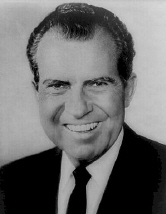| United States
History
Although Nixon subscribed to the Republican value of fiscal responsibility, he recognized the need for government's expanded role and accepted the basic contours of the welfare state. He simply wanted to manage its programs better. Nixon confronted a series of economic problems during his presidency. By 1973 the inflation rate was 9 percent; the Dow-Jones average of industrial stocks fell 36 percent between November 1968 and May 1970; and the unemployment rate reached 6.6 percent by the end of 1970. Nixon imposed wage-price controls in 1971, but they did little good. Factors beyond Nixon's control undermined his economic policies. In 1973 the war between Israel, Egypt and Syria prompted Saudi Arabia to impose an embargo on oil shipped to Israel's ally, the United States. Other member nations of the Organization of Petroleum Exporting Countries (OPEC) quadrupled their prices. Americans faced both shortages and rapidly rising prices. Even when the embargo ended the next year, prices remained high. Higher energy prices affected all areas of American economic life: in 1974 inflation reached 12 percent, causing disruptions that led to even higher unemployment rates. This era of recession and inflation ("stagflation") brought an end to the unprecedented economic boom America had enjoyed since 1948. While trying to manage the economy, Nixon also sought to restore "law and order." Rising crime rates in American cities and political protests, increased drug use and more permissive views about sex in U.S. universities offended many Americans. Seeking to strengthen his own political constituency, Nixon chose to use government power to counter disruption. He lashed out at demonstrators, attacked the press for distorted coverage and sought to silence his opponents. That strategy backfired in the Watergate affair. Facing Democratic majorities in both houses of Congress during his first term, Nixon wanted to win an overwhelming re-election victory in 1972 that would bring Republican congressional majorities and end the legislative stalemate. The Committee to Re-elect the President launched a massive fund-raising campaign to collect money before contributions had to be reported under a new law. Early in 1972, Nixon's team proposed to tap the telephones of the Democratic National Committee in the Watergate apartment complex in Washington, D.C. The attempt failed. When the burglars, carrying money and documents that could ultimately be traced to The White House, were arrested, the administration decided to cover up its involvement. Six days after the discovery of the break-in, Nixon told the Central Intelligence Agency to order the Federal Bureau of Investigation to cease its investigation on the grounds that national security was at stake. In fact, the break-in was just one aspect of a campaign to locate and destroy people whom the administration considered its "enemies." These activities involved illegal wiretapping, break-ins and fundraising. Although Nixon was overwhelmingly re-elected that year, the press, particularly the Washington Post, continued to investigate. As the scandal unfolded, the Democratic majority in the Congress instituted impeachment proceedings against Nixon. As the evidence of his involvement began to mount, he resigned on August 9, 1974. 
Custom Search
Source: U.S. Department of State |
 Richard
Nixon took office after eight years of Democratic rule. Vice
president under Eisenhower before his unsuccessful run for the
presidency in 1960, Nixon embraced politics, but without the passion of
President Johnson. Distant often appearing ill at ease, he was always
calculating his next move. That helped him at first, but finally led to
his downfall.
Richard
Nixon took office after eight years of Democratic rule. Vice
president under Eisenhower before his unsuccessful run for the
presidency in 1960, Nixon embraced politics, but without the passion of
President Johnson. Distant often appearing ill at ease, he was always
calculating his next move. That helped him at first, but finally led to
his downfall.